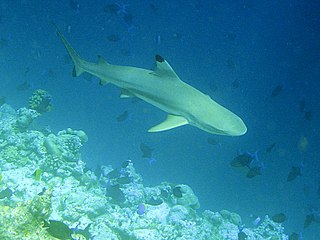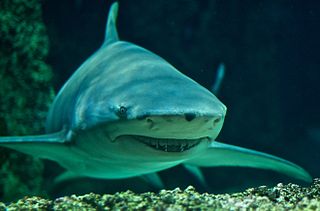
Requiem sharks are sharks of the family Carcharhinidae in the order Carcharhiniformes. They are migratory, live-bearing sharks of warm seas and include such species as the bull shark, lemon shark, blacktip shark, and whitetip reef shark.

Bimini is the westernmost district of the Bahamas and comprises a chain of islands located about 80 kilometres (50 mi) due east of Miami. Bimini is the closest point in the Bahamas to the mainland United States and approximately 210 km (130 mi) west-northwest of Nassau. The population is 2,417 as of the 2022 census.

The lemon shark is a species of shark from the family Carcharhinidae, known for its yellowish color, which inspires its common name. It is classified as a Vulnerable species by the International Union for the Conservation of Nature. Lemon sharks can grow to 3.4 metres (11 ft) in length. They are often found in shallow subtropical waters and are known to inhabit and return to specific nursery sites for breeding. Often feeding at night, these sharks use electroreceptors to find their main source of prey, fish. Lemon sharks enjoy the many benefits of group living such as enhanced communication, courtship, predatory behavior, and protection. This species of shark gives birth to live young, and the females are polyandrous and have a biennial reproductive cycle. Lemon sharks are not thought to be a large threat to humans; there have been 10 recorded bites, none of which were life-threatening. The lemon shark's life span is unknown, but the average shark is 25 to 30 years old. The oldest recorded lemon shark in captivity died in 2023 at the age of 40 years.
Squalus is a genus of dogfish sharks in the family Squalidae. Commonly known as spurdogs, these sharks are characterized by smooth dorsal fin spines, teeth in upper and lower jaws similar in size, caudal peduncle with lateral keels; upper precaudal pit usually present, and caudal fin without subterminal notch. In spurdogs, the hyomandibula is oriented at a right angle to the neurocranium, while in other sharks, the hyomandibula runs more parallel to the body. This led some to think that the upper jaw of Squalus would not be as protractile as the jaws of other sharks. However, a study that compared different jaw suspension types in sharks showed that this is not the case and that Squalus is quite capable of protruding its upper jaw during feeding.

Fernando de Noronha Marine National Park is a national park in the state of Pernambuco, Brazil.

The sicklefin lemon shark or sharptooth lemon shark is a species of requiem shark belonging to the family Carcharhinidae, widely distributed in the tropical waters of the Indo-Pacific. It is closely related to the better-known lemon shark (N. brevirostris) of the Americas; the two species are almost identical in appearance, both being stout-bodied sharks with broad heads, two dorsal fins of nearly equal size, and a plain yellow-tinged coloration. As its common name suggests, the sicklefin lemon shark differs from its American counterpart in having more falcate (sickle-shaped) fins. This large species grows up to 3.8 m (12 ft) long. It generally inhabits water less than 92 m (302 ft) deep in a variety of habitats, from mangrove estuaries to coral reefs.

The blacknose shark is a species of requiem shark, belonging to the family Carcharhinidae, common in the tropical and subtropical waters of the western Atlantic Ocean. This species generally inhabits coastal seagrass, sand, or rubble habitats, with adults preferring deeper water than juveniles. A small shark typically measuring 1.3 m (4.3 ft) long, the blacknose has a typical streamlined "requiem shark" shape with a long, rounded snout, large eyes, and a small first dorsal fin. Its common name comes from a characteristic black blotch on the tip of its snout, though this may be indistinct in older individuals.

The tawny nurse shark is a species of carpet shark in the family Ginglymostomatidae, and the only extant member of the genus Nebrius.
The weasel sharks are a family, the Hemigaleidae, of ground sharks found from the eastern Atlantic Ocean to the continental Indo-Pacific. They are found in shallow coastal waters to a depth of 100 m (330 ft).

The sicklefin weasel shark is an uncommon species of ground shark in the family Hemigaleidae. It is native to southern India, southern China, and parts of Southeast Asia, living in shallow waters down to a depth of 170 m (560 ft). This lightly built shark is characterized by its very short mouth, broad upper teeth with serrations only on the trailing edge, and strongly sickle-shaped fins with obvious white tips on the two dorsal fins. It is light grey or bronze in colour, often with small white blotches on its sides; it reaches a maximum known length of 1.1 m (3.6 ft).
Samuel H. Gruber was a shark biologist and founder of the American Elasmobranch Society. He was a professor at the University of Miami's Rosenstiel School for Marine and Atmospheric Science and the founder of the Bimini Biological Field Station Foundation.

The Gulf wobbegong or banded wobbegong is a species of carpet shark in the family Orectolobidae, found in southern Australia between Southport, Queensland and Norwegian Bay, Western Australia.

Carcharias is a genus of mackerel sharks belonging to the family Odontaspididae. Once bearing many prehistoric species, all have gone extinct with the exception of the critically endangered sand tiger shark.
SharkDefense is a research organization and think tank focused on shark bycatch reduction. Its core research involves chemical and electrochemical shark repellent technologies. SharkDefense's repellent experiments have been featured extensively in the US and European media.
Magnetic shark repellents utilize permanent magnets, which exploit the sensitivity of the Ampullae of Lorenzini in sharks and rays (electrosense). This organ is not found on bony fish (teleosts), therefore, this type of shark repellent is selective to sharks and rays. Permanent magnets do not require power input, making them practical for use in fisheries and as bycatch reduction devices. Sharkbanz, released in 2014, is a wearable commercially available device intended for recreational users. Its manufacturers cite numerous scientific papers which support the effectiveness of permanent magnets in a range of contexts. A field study of a range of shark deterrents in 2018 found that Sharkbanz were ineffective when used in a temperate oceanic setting with berley-attracted Great white sharks.
Hemigaleus is a genus of weasel shark in the family Hemigaleidae. It is characterized by a rounded snout and short gill slits. The mouth is short and broadly arched; the teeth have very short cusps, without toothless spaces at the jaw midlines. The dorsal and pelvic fins, and the lower caudal lobe are strongly falchate. At one time or another, this genus has encompassed up to nine species, but most were eventually split off into other genera. Neogaleus Whitley, 1931 is a junior synonym of this genus.
Negaprion eurybathrodon is an extinct species of lemon shark, which existed globally from the Late Eocene to the Pliocene. It was described by Blake in 1862.
Polyandry in fishes is a mating system where females mate with multiple males within one mating season. This type of mating exists in a variety of animal species. Polyandry has been found in both oviparous and viviparous bony fishes and sharks. General examples of polyandry occur in fish species, such as green swordtails and Trinidadian guppies. Specific types of polyandry have also been classified, such as classical polyandry in pipefish cooperative polyandry in cichlids and convenience polyandry in sharks.












